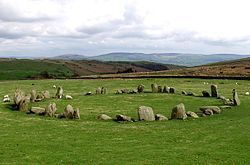




Recovery from Disaster
Haplogroup L161 had been living an easy life in Doggerland until the "8.2 kiloyear event" almost exterminated them. The few survivors washed up on the shores of the English Channel to recover. S2639 Isles AB formed and split. A very few, perhaps just one, were on the eastern shore of East Anglia and a few more were on the western shore of the continent. The recovery was helped by the arrival of the especially warm climate of the 'Atlantic' period. It was impeded by the cultural isolation caused by the open water barrier of the English Channel.
8,200 y.a. ___After the Doggerland disaster, Britain became isolated.
7,000 y.a. __Isles AB, S2639 emerged from the survivors of L-161
6,700 y.a. __Isles B - L1498 emerged from Isles AB, S2639
4,700 y.a. __The Bell Beaker invasion began and continued for over 300 years
8,200 y.a. ___After the Doggerland disaster, Britain became isolated.
The rising sea level and the Storegga Tsunamis changed the geography. The English Channel, previously not much more than a river, became a serious open water obstacle.8,000 y.a. __ Kongemose culture had developed in Doggerland.
The survivors of the 8.2 kiloyear event took that culture with them. With the shoreline resources devastated, they concentrated more on hunting red deer, roe deer and wild boar with stone axes and spears. Kongemose microlith tools that were made on the continent are very similar to those made along the English shoreline - hypothetically - by the L-161 survivors. English technology was stagnant until the neolithic revolution after 6,500 y.a.7,500 y.a. __The Atlantic climate period began, warmer than now.(7,500-5,000 y.a.)
7,000 y.a. __Isles AB, S2639 emerged from the survivors of L-161
6,700 y.a. __Isles B - L1498 emerged from Isles AB, S2639
Isles B immediately produced several branches: Y12993, A10029, and Y3749. This abrupt proliferation is indicative of a benevolent environment. The delta of the Rhine River would have been such a place at that time, quite similar to the lost Doggerland environment.6,700 y.a. __Isles A - Y12072 emerged from Isles AB, S2639
Isles A, in stark contrast, did not produce a single surviving branch for 3,700 years. This is indicative of a very hostile environment with the population on the edge of extinction the whole time. The unfamiliar environment of the rocky shores of Albion would have presented a severe challenge to those mesolithic refugees.6,500 y.a. __Mesolithic / Neolithic transition
In an astonishingly short period of about 200 years all the continental mesolithic groups adopted an entirely new way of life involving keeping domestic animals, cutting hay to feed the animals, ability to milk the animals, pottery to hold the milk, the ability to make cheese, and many other things known as the "secondary products revolution". By natural selection, Lactose tolerance begins to evolve among dairy herders. The whole cluster of advances is lumped together as the "neolithic revolution. The blazing fast speed of the transition was perhaps aided by exogamous patrilocal marriage practices in which the bride took her dowry of a calf and the knowledge of dairy practices and pottery making to her new husband's home. Isles B was probably a major beneficiary of these new ways, but the physical isolation of England significantly delayed and slowed the transition there, so Isles A's dire situation was not improved.6,000 y.a. __Stone circles introduced into England
The stone circle construction started in coastal areas in northern England. Isles A was living in England, but the tiny size of the tribe was not large enough to add significantly to the construction.5,370 y.a. __TMRCA of the 'continental' group of L161 - Isles B
TMRCA = Time to Most Recent Common Ancestor5,000 y.a. __End of the Atlantic warm period; beginning of the Subboreal climate period
4,700 y.a. __The Bell Beaker invasion began and continued for over 300 years
